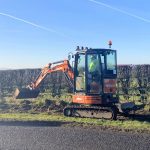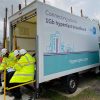Recent UK Storms Damaged 650 of Openreach’s Telegraph Poles UPDATE

Last month was unusual for a number of reasons, not least of which was the fact that – in the space of just six days (16th to 21st of February) – the UK experienced three named storms (Dudley, Eunice and Franklin). As a result, over 650 of Openreach’s broadband and phone carrying poles were “badly damaged and need replacing“.
The single worst storm out of the three turned out to be Storm Eunice, which generated two rare red warnings for wind – with some gusts reaching up to 122mph – and has been named by the Met Office as the “most severe and damaging storm” to affect England and Wales since February 2014. Admittedly, the impact of such events does depend somewhat upon where you live.
Openreach, like many other broadband and telecommunications firms, suffered a fair bit of damage and disruption to some parts of their network – due to the impact of flooding, snow, major power cuts and high winds. But in this case, we’re going to concentrate on the hot topic of telegraph poles, which have a growing tendency to divide public opinion (examples here, here, here and here).
Advertisement
Opponents of such poles, who frequently complain about their visual appearance (particularly when they’re built into an area that didn’t previously have them), often like to highlight concerns over their durability due to the risk of damage from major storms – a risk that many would suggest is only going to increase due to climate change.
Sadly, getting any solid data on this is hard (e.g. long-term costs – inc. repairs – of overhead vs underground infrastructure), but the recent storms may have given at least a limited indication. Openreach states that more than 650 of their poles were “badly damaged and need replacing” during the storms.
Openreach Statement
“This is some of the most time-consuming repair work we do, as it needs specialist equipment to lift and place the pole, and often we need to gain permission to use safety measures like road closures or temporary traffic lights – which are vital. In some places we’ve had to replace as many as five poles in a row, so it can be very time consuming.”
However, it’s important to put this into some perspective, since Openreach has more than 4 million poles across the United Kingdom, some of which are as much as 15 metres high (8-9m is more common). Put another way, the storms damaged just 0.02% of their overhead network, and that really was some truly exceptional weather. The operator states that their poles are “incredibly robust and tested regularly“, but inevitably some of them do succumb to high winds and falling trees.
The cost to replace a damaged pole is a difficult thing to pin down, due in part to the issues mentioned by Openreach above and the complexity of the damage itself (e.g. did the pole just break or has the foundation been destroyed too). Not to mention that there may be a cost to replace any kit at the top of the pole, if it was damaged.
Advertisement
The poles themselves aren’t very expensive to buy, relatively speaking, but costs do add up once you consider all the labour, admin and permissions needed for installation. Alternative network providers tell us that the cost of just installing a new (not damaged) pole can range from around £550 to over £1,000, which makes them quite cost-effective and not a particular concern for the bean counters.
The other issue is of how long it actually takes to replace a pole, which of course depends more upon the wider issues of road permits/permissions, availability of engineering resources and the level of local damage etc. We’ve seen before how some homes in remote rural areas have been left to wait for 8-12 weeks before repairs in cases of extreme damage (rare), but in urban areas a downed pole may be a matter of hours or just a few short days. We did ask Openreach if they could provide some official figures and are still waiting.
At present, telegraph poles are enjoying somewhat of a renaissance, with many operators using them to help expand the coverage of their Fibre-to-the-Premises (FTTP) broadband networks. The impact from the recent storms seems unlikely to change that. Lest we forget that poles continue to be common in some countries where typhoons and hurricanes are a regular occurrence, thus weather alone is not enough to change the argument.
Poles remain a common sight across much of the UK, and you can find plenty of people who would be more than happy to accept their deployment if it meant gaining access to a full fibre network. Likewise, there seems to be no shortage of studies claiming to show how the provision of faster broadband networks – via either pole or underground cables – tends to result in house values going up, rather than down.
Advertisement
Naturally, we’d all prefer it if broadband and mobile infrastructure was totally invisible, but that’s not always economically feasible because underground deployments tend to be significantly more expensive. In some areas the choice is thus between either having poles or no fibre at all.
UPDATE 8th March 2022
Openreach informs that, for storm related issues, it is currently taking around 20 days to fix damaged poles. We also found some more details about how Openreach test their poles (here).
Mark is a professional technology writer, IT consultant and computer engineer from Dorset (England), he also founded ISPreview in 1999 and enjoys analysing the latest telecoms and broadband developments. Find me on X (Twitter), Mastodon, Facebook, BlueSky, Threads.net and Linkedin.
« ISP Gigaclear Freezes Prices for 18 Months – Ahead of 2023 Hike























































I find it strange that other countries utilise concrete posts for their phone and lower voltage electricity supplies.
In France, where there is lots of wood, I never saw a wooden pole, and having suffered two tempets, yes the power went off, but this was due to a tree falling on the line. Never lost the phone. Never saw a downed pole.
You mean “some” other countries, wood is still popular due to its many pros, and those tend to make up for the cons.
Concrete poles are indeed strong and durable, but they’re also very difficult to handle (weight), difficult to affix things to, have a higher cost, require reinforcing bars.. that will corrode, take a lot more energy to create, can be much more dangerous at the roadside when they fall (they do still fall) and are considered environmentally unfriendly.
So why not a steel pole, like the street lights? seems like this is one of them problems that has already been solved. When was the last time you saw a street light downed during a storm (not someone hit it with a car?)
@Derringer Openreach do also use steel poles though I’ve heard they actually are more of a pain for the engineer since they can’t just get up them with a ladder.
No doubt BT will replace them with more wooden poles then? It’s like mind boggling that they still remain on so many UK streets in 2022 supplying BT’s pretend fiber isn’t it?
How is full fibre served by Poles pretend fibre?? less faults occur overhead than overground as a fact
*Underground
You’re telling me they actually put real fiber up poles?!!!
Yes, they do. It’s common practice with altnets too (using electrical pylons also). My house is served by overhead fibre.
Where’s the proof of that then Jason? Seems highly unlikely the propensity for underground fibre or cooper to be more issue prone than overhead? If that was the case it’d be the default.
Your pole may not have full fibre on it but there is a bigger world.
Millions of premises have full fibre via poles.
@Buggerlugz
Your comment about pretend fibre just because of wooden poles is probably the craziest thing you have ever said.
Weirdest comment of the year award goes to (drum roll)….Buggerlugz, Congratulations 🙁
Gary I work for Openreach and Jason is right , most faults occur in the underground network.
@Buggerlugz
Overhead “real fibre” has been a thing for a decade, is a cost-effective delivery method compared to underground in many circumstances and is a lot less disruptive than putting in new ductwork too.
@lugz
You post an awful lot of opinions for someone with such a slim grasp of facts.
Buggzy makes himself look a fool again.
You have thought they’d have gotten bored of that by now but apparently not.
By pretend fibre I guess you mean fibre from the cabinets, using the copper ‘last mile’ network,
But as they’ve pointed out, also fibre on poles now just look for the yellow labels at head height
They do indeed my FTTP is pole fed
Interesting that the photo chosen above appears to be a shared distribution pole with both OR FTTP and an Altnet splitter (similar to those used by FW). Which goes to highlight that even where there is overbuild both networks may be dependant on shared infrastructure.
I have personally also seen both Cityfibre and FW not providing provision to every DP pole and therefore on occasion I assume they will loop via an adjacent pole if necessary.
Then there is the rural situation where there are many intermediary pole spans.
How the underlying provider serves your particular property may need to be considered if resilience is high on your list. But in many cases you will not know what is being shared so a fixed/mobile combo has to be the way forward.
Correct.
The pole that feeds fibre to my property isn’t fed from the ground its aerial fed via the next pole down, ours is the last pole on the street.
@meadmodj that is a 20 pair copper block and a 12 port CBT on the pole – both Openreach
Could also point to the awful state of a lot of OR poles.
OR have themselves said that they have a lot of poles that date back to the days of the telegram.
Often on here we previously had comments from OR guys saying that pole condition is a limiting factor in FTTP rollout.
Really?
650 out of how many poles across the UK?
Out of 4million as the article says
I have dual cable and 5G as I WFH and need to be online as I’m also contracting, so no internet = no pay today. My 5G went out, my personal phone on a totally different network went out, but my cable stayed up. I’m sure a lot of other people in storm affected areas (and I mean like trees and telegraph poles falling down, not your wheelie bin fell over type areas) with underground cables were grateful for that too.
I dislike the telegraph poles. But I also realise it’s not feasible to put underground cables and ducts everywhere. I’m just grateful (for once) that I had cable internet, the only reason I have 5G as well is because I found virgin media to be extremely flakey.
There is a website dedicated to telegraph poles, ( https://www.telegraphpoleappreciationsociety.org/ ) & apparently poles will potentially last a significant amount of time (100+ years in some, possibly outlying, cases) certainly we’ve got some around here (Kent) that are well over 60 years old & have just passed their inspection (a couple in my garden were, according to their labelling, “planted” in 1958). We’ve just had a roll out of fttp locally (CFP) & the delays have largely been caused by blocked ducts & lack of manpower due to the large number of projects.
Certainly a few poles around here that were clearly installed in pre-twisted pair days, from the t-bar and porcelain insulators on the top